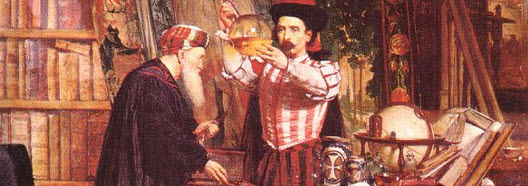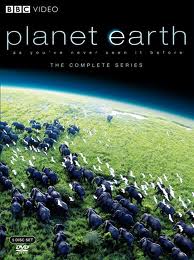The Planet Earth BBC Series
The Planet Earth series was released in 2006 by the BBC Natural History unit, the most expensive nature documentary series ever commissioned by the BBC, and the first shot in high-definition. The series has become a favorite of biology and environmental science classrooms for its amazing footage, groundbreaking quality, and depth of information.
There are a total of 11 episodes of Planet Earth. The worksheets and student guides I have written for this series are all based on the BBC version starring David Attenborough as the narrator. I have not written anything for the From Pole to Pole episode, as it is largely a recap of the other episodes.
Each episode provides a tremendous opportunity for "teachable moments." Whether your focus is biology, earth science, or ecology, there is a good chance your concepts are covered by one more more of these episodes.
Tip for teachers: Use closed captioning! Many of the animals and plants have very unusual names with very unusual spellings! Seeing them in text makes it much easier for the students to follow!
Planet Earth Teacher's Guide for Episodes 1-5
This is a guide for teachers using Planet Earth in their environmental science or biology classes. I highlight and explain some of the important ideas and concepts covered within each episodes that would be relevant and appropriate for high school and undergraduate college courses.
The guide only covers the first five episodes: mountains, fresh water, caves, deserts, and ice worlds.
Planet Earth - Mountains
Key Concepts: Effects of altitude on climate, animal adaptations, abiotic factors of ecosystems, symbiotic relationships, K-strategists, r-strategists.
Teachable Moments: The segment on the giant panda illustrates how competition for scarce resources can drive speciation. The giant panda lives in an ecosystem where it must subsist on a very nutrient-poor food, bamboo. However, the ability of the panda to survive on bamboo allows it to live relatively free from competition with other species over food.
Planet Earth - Deep Ocean
Key Concepts: This is a worksheet set for students to complete as they watch the Planet Earth deep oceans video. This episode provides a great contrast between traditional photosynthetic ecosystems that rely on sunlight as their base source of energy and chemosynthetic ecosystems that rely on inorganic chemicals, such as that from a underwater volcanic vent.
Teachable Moments: Many students have only learned about biological communities with photosynthetic producers at the base. The communities shown in this episode rely instead on either dead and decomposing organic matter, or inorganic chemicals released from volcanic vents such as hydrogen sulfide.
Planet Earth - Deserts
Key Concepts: Effects of latitude on climate, animal adaptations, abiotic factors of ecosystems, types of deserts (tropical, temperate, and polar)
Teachable Moments: The Nubian Ibex is an example of how sexual selection can drive the natural selection of a species. The juvenile ibex males are shown fighting with each other in an effort to establish a hierarchy of dominance. The mature, dominant ibex is also shown travelling with a harem of female ibex. The idea here is that the male ibex that bests his competition has stronger genes, making him stronger, faster, smarter, or otherwise superior to the others. By choosing this male, the female ensures her offspring will also have these genes.
Planet Earth - Ice Worlds
Key Concepts: Effects of latitude on climate, animal adaptations, abiotic factors of ecosystems, permafrost, seasons, climate change, global warming
Teachable Moments: This is the only episode of Planet Earth to directly address human impacts on natural ecosystems. Specifically, the segments showing the male polar bear's attempts to find a hunting grounds and his subsequent failure at capturing a walrus illustrate the fragility of the arctic ecosystem. The polar bear is dependent on thick ice for seal huntin grounds. As sea temperatures increase, and more of this ice is lost, much of their hunting grounds are no longer available.
Planet Earth - Shallow Seas
Key Concepts: Aquatic ecosystems, food webs, food chains, photosynthesis, mutualism, competition, animal and plant adaptations
Teachable Moments: For each of the aquatic ecosystems shown in this episode, plankton and other protists serve as keystone species. The entire biological community revolves around the growth and decline of these microorganisms.
Planet Earth - Great Plains and Grasslands
Key Concepts: Effects of latitude on climate, animal adaptations, abiotic factors of ecosystems, types of grasslands (temperate, tropical, polar)
Teachable Moments: Prairie fires are a natural part of this ecosystem. Any animals or plants who occupy the grassland as a habitat must be adapted in some way for surviving the flames. In the case of prairie plants and grasses, their roots run very deep and are able to resprout very quickly. Nearly every animal of the grassland either has the ability to run quickly or tunnel underground. This episode showcases both responses.
Planet Earth - Jungles
Key Concepts: Effects of latitude on climate, animal adaptations, abiotic factors of ecosystems, layers of a forest (canopy, understory, floor), reproductive isolation
Teachable Moments: The very first sequence shown in this episode has several different species of Birds of Paradise exhibiting their mating dances and display rituals. The birds, although closely related and physically very similar, do not interbreed. This is an striking example of reproductive behavioral isolation.
Planet Earth - Freshwater
Key Concepts: Dissolved oxygen, turbidity, parts of a river (rapids, run, riffle, pool), types of aquatic organisms (plankton, nekton, benthos)
Teachable Moments: The episode begins by showing a part of a river near its source; where the water is very cold and moving very quickly. The animals here have very unique adaptations for staying anchored to the bottom of the river, extracting nutrients from the water, and breaking oxygen from the water.
Planet Earth - Seasonal Forests
Key Concepts: Effects of latitude on climate, animal adaptations, abiotic factors of ecosystems, layers of a forest (canopy, understory, floor), seasons, deciduous trees, r-strategist
Teachable Moments: The periodical cicadas emerge after 17 years underground. This produces a flood of cicadas throughout the entire forest. These arthropods are a great example of an r-strategist. They are big, slow, and do not have any effective defensive mechanisms. However, their sheer numbers ensures a high enough survival rate to continue the species
Planet Earth - Caves
Key Concepts: Food webs and energy flow, stalagtites, stalagmites, erosion, minerals, animal adaptations, vestigial structures
Teachable Moments: Vestigial structures, such as the appendix of humans, are parts of the body that exist, but in a very diminished way. These are often cited as evidence of evolution. This episode of Planet Earth includes two animals who are blind, but are closely related to species that have eyesight. These are the cave angel fish and the Texas cave salamander. These two animals are good examples of speciation occuring and leading to eyes becoming vesgitial, and eventually disappearing altogether.


